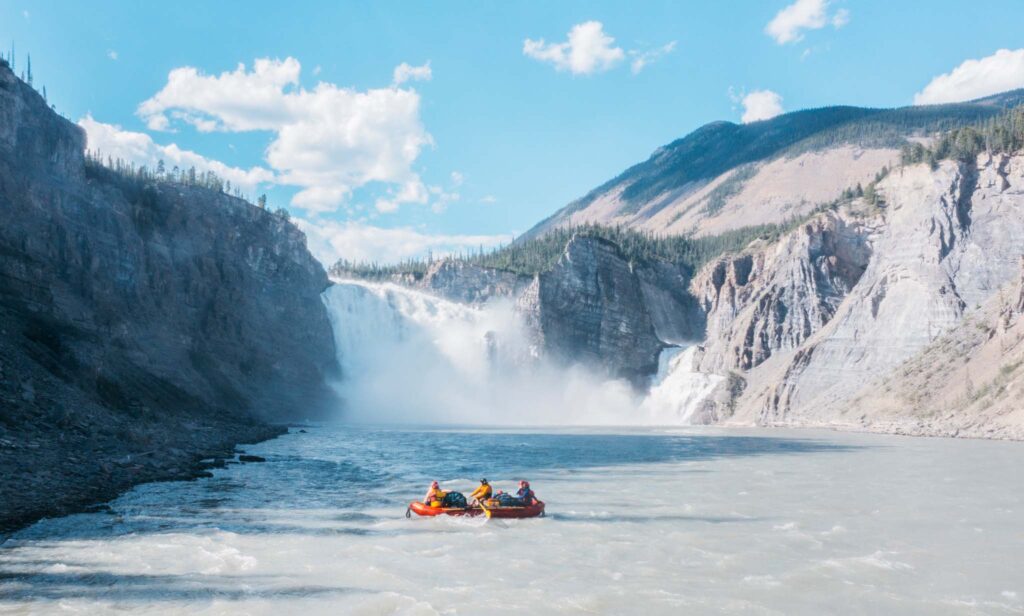
Categories
- No categories
- more

In Nahanni National Park Reserve, there’s no spot as celebrated as Virginia Falls. It’s a thundering and furious wall of whitewater, four acres in size and 300 feet high. Virginia Falls is one of the many spectacular natural wonders in Nahanni National Park Reserve, and its powerful presence can be heard – and even felt – on your approach.
There are many ways to experience the majesty of Virginia Falls – whether it’s from above on a flightseeing tour out of Fort Simpson, from up close on the historic Virginia Falls portage trail, or from the comfort of your campsite at the Virginia Falls campground.
You can reach the brink of the falls via the park’s famous portage-trail boardwalk. At the lip of the falls, the Nahanni River whips itself into a fury, plunging through the notorious Sluicebox rapids and hurtling off to crash far below. The roar of the waves is deafening; the stony ground shudders; the air itself is churned into a maelstrom. No viewpoint on Earth is so humbling.
If you’re up for a hike, the 16-kilometre round-trip climb up to Sunblood Peak climbs higher than the falls themselves, so you can enjoy the pure power of one of Nahanni National Park Reserve’s most impressive sights. No matter how you see it, you’ll agree Virginia Falls is a must-see destination in Canada’s Northwest Territories.

Inside the scenic Blackstone Territorial Park is this intriguing interpretive centre that’s worth a visit all on its own, even if you’re just stopping to camp or passing through.
The visitor’s centre has details about local adventure tours, as well as current weather and river conditions. It also features interpretive displays and video information about the First Nations history of the area.
Located at the convergence point of three rivers – the Peace, Liard and Mackenzie – Blackstone has long held significant importance to the Dehcho Dene, serving as an vital transportation route and hunting and fishing area.
You can find out more about this fascinating region from the friendly staff at the Blackstone Visitor Information Centre, which is open seven days a week during parks season (mid-May to mid-September), from 8am to 11pm.

One of the finest galleries in all of the Northwest Territories, this sunny store is an essential stop for travellers on the Liard Highway. Here you’ll find handmade birchbark baskets, moosehide moccasins, and authentic beaded accessories. A wealth of Indigenous artworks and traditional crafts are for sale, and the shopkeepers are brimming with handy information about the area.
The Deh Gáh Got’îê Dene who live in the Dehcho region traditionally would move with the seasons – hunting, trapping and fishing off the land. They made abundant use of the resources around them while developing strong artistic styles still present in their crafts today.
The Acho Dene Craft Store began operating in 1976. Over 40 local crafters and artists living in the community lovingly and carefully produce the products sold here. The items are usually a blend of ancestral techniques and themes, combined with traditional and modern materials. The business also staffs and maintains a tourist kiosk for the Government of the Northwest Territories Department in its shop, located in the beautiful community of Fort Liard.

On the floodplain where the Liard River flows into the great Mackenzie, a crowd of Northerners gathered in 1984 awaiting the arrival of Pope John Paul II. Unfortunately, fog prevented His Holiness’ plane from landing and the visit was postponed. Three years later, the Vatican once again turned its eyes toward the Northwest Territories and the Pope finally arrived in Fort Simpson, holding a mass at this site for a crowd of 3,500.
Today, three structures still remain from the Pope’s visits: a 15 metre-high teepee log frame, used as a stage; a log-framed Drum Circle structure that reaches 38 metres in diameter; and a concrete podium/monument in the form of a cross, representing the four directions and the four natural elements.
This area of the Ehdaa Historical Site is still used in summer gatherings to celebrate and pray, as well as for community events like the annual Open Sky Festival.

This small but resilient day use park, which boasts the magnificent 17-metre McNallie Creek Falls, was affected by the wildfires of 2023. The park is currently undergoing restoration efforts to return it to its former splendor. We look forward to welcoming visitors and residents next season to enjoy this stunning roadside gem once again

This idyllic park overlooks the confluence of the Mackenzie and Liard rivers, yet is within easy walking distance of the centre of town. Adjoining it are the Papal Site commemorating the 1987 visit of Pope John Paul ll and the ancient Ehdaa Historical Site, which has been a gathering place for the Łiidlįį Kų́ę́ Dene for generations.
This is a great location for bird-watching; dozens of species have been documented throughout the park, and migratory waterfowl can easily be spotted in season, including tundra swans and snow geese. You can also enjoy the chorus of frogs serenading the northern wildlife. A community trail is readily accessible from the park’s campsites and runs around the perimeter of Fort Simpson, linking several historic sites.